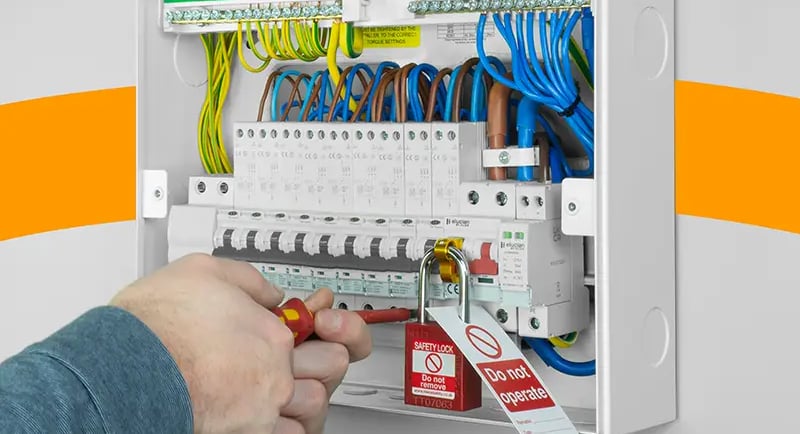Consumer Units (Fuseboxes) and Electrical Safety
This is information on choosing a consumer unit for domestic houses.
Jim Ascroft
6/5/20255 min read


An RCBO (Residual Current Breaker with Overcurrent protection) combines the functions of both an RCD (Residual Current Device) and an MCB (Miniature Circuit Breaker), while an RCD protects only against earth leakage (residual current). An RCBO provides both earth leakage and overcurrent protection, while an RCD only protects against earth leakage.
RCD (Residual Current Device):
Primary Function: Protects against electrical shocks caused by earth leakage (where current flows to earth instead of through the intended path).
Mechanism: Detects an imbalance in current between the live and neutral wires, indicating a leakage to earth. If the imbalance exceeds a certain threshold (e.g., 30mA in some regions), the RCD trips, disconnecting the circuit to prevent shock.
Overcurrent Protection: RCDs do not provide protection against overloads or short circuits.
Cost: Generally less expensive than RCBOs.
RCBO (Residual Current Breaker with Overcurrent protection):
Primary Function:
Protects against both earth leakage (like an RCD) and overcurrent (overload and short circuits).
Mechanism:
Combines the earth leakage detection mechanism of an RCD with the overcurrent detection mechanism of an MCB.
Overcurrent Protection:
The MCB part of the RCBO trips when the current exceeds the breaker's rating, providing protection against overload and short circuits.
Cost:
Generally more expensive than RCDs ( used in split type main boards) but have many advantages
If you only need protection against earth leakage (and potentially save money), an RCD is sufficient.
If you need protection against both earth leakage and overcurrent (and are willing to pay a bit more), an RCBO is a better choice.
Questions and Answers
Do the Wiring Regulations require all 13 A socket-outlets in a dwelling to be RCD protected?
Yes.
Regulation number(s):
411.3.3
BS 7671 requires most if not all circuits in domestic premises to be RCD-protected. There have been a number of suggestions as to how the consumer unit may best be configured to comply with the Regulations, the most common being a main switch with RCBOs protecting each individual circuit. However, another suggestion favours a main switch with two RCDs protecting separate DIN rails. If careful consideration is given as to what each bar will control in the way of upstairs and downstairs lighting and power circuits, will this configuration comply?
Yes, as long as the division of final circuits between the RCDs is carefully considered so as to minimize the consequences of unwanted tripping. Separate RCD protection is not necessarily required for each circuit of an installation but, in order to minimize the likelihood and consequences of tripping, a single (‘front end’) RCD should not be used to protect all the circuits.
Regulation number(s):
314.1
Why don't you fit RCD protected split main boards considering that they are cheaper?
We don't fit RCD split main boards as often as before because they can cause nuisance tripping and lack circuit discrimination, which can lead to the loss of power to several circuits if one RCD trips. Modern installations typically use RCBOs(Residual Current Breakers with Overcurrent protection) because they offer better individual circuit protection, reducing the risk of a single fault affecting the entire property.
Disadvantages of split-load boards
Nuisance tripping:
In a split-load board, each RCD protects a group of circuits. If the total earth leakage from all the circuits under one RCD's protection exceeds a certain threshold (e.g., 9mA) for a 30mA RCD
it can trip unnecessarily.
Lack of discrimination:
When an RCD trips, it cuts power to all the circuits it protects, which can cause a complete loss of power to a significant part of the house.
Safety risk:
If one RCD trips, it can lead to a loss of light in multiple areas, which can be dangerous, especially for vulnerable individuals.
Why RCBOs are preferred
Individual circuit protection:
An RCBO protects a single circuit from both earth leakage and overcurrent. This means if one circuit has a fault, only that specific circuit will lose power, and the rest of the house will remain live.
Improved safety:
By isolating faults to individual circuits, RCBOs provide better protection against electric shock and fire.
Better control:
RCBOs offer more control, allowing for better isolation of faults without affecting other parts of the installation.
Conclusion
While split-load boards can be a cost-effective option, especially in smaller properties, they are being phased out in favour of RCBOs due to the safety and inconvenience concerns associated with nuisance tripping and the lack of individual circuit protection.
Are Surge Protection Devices required for new installations under BS7671?
Yes, surge protective devices (SPDs) are required for new electrical installations in the UK under the 18th Edition Wiring Regulations (BS7671), unless a risk assessment proves they are not needed. This requirement applies to virtually all new installations, including those in homes and commercial buildings, particularly when overvoltage could lead to injury, failure of safety services, or significant financial/data loss.
Key requirements for SPDs
Mandatory for new installations:
SPDs are now mandatory for new installations unless a risk assessment can justify their omission.
Exceptions:
An SPD is not required if a formal risk assessment concludes that the risks from overvoltage are negligible. Examples of when SPDs would be required even without a formal risk assessment include installations where overvoltage could cause serious injury, failure of a safety service, or significant financial or data loss.
Domestic and commercial:
The requirement applies to both domestic and commercial properties.
Risk assessment default:
If an electrician does not carry out a risk assessment, SPDs must be installed by default.
Consequence of non-compliance:
A lack of SPDs in an installation that requires them will result in a "C2" (urgent remedial work needed) code on an Electrical Installation Condition Report(EICR).
Information notice:
Installers must provide an information notice at or near the distribution board, explaining the presence or absence of surge protection.
retrofit:
While SPDs are mandatory for new installations, they can also be retrofitted into existing systems.
Why a SPD is required
Legal requirement:
Since January 2019, BS 7671 requires SPDs for new installations unless a risk assessment proves they are not needed. This requirement was reinforced in the 2022 Amendment 2 update.
Risk assessment:
The regulations have removed previous exemptions for many types of buildings, including single-dwelling units. For an installation to be compliant without an SPD, a formal risk assessment must be conducted and agreed upon by the client, who must then accept responsibility for any potential loss or damage.
Insurance implications:
Homeowners who decline an SPD may find that their insurance policy will not cover damage caused by power surges.
Classification:
The lack of a required SPD will be noted in the EICR, likely with a C2 code, indicating an urgent need for improvement to enhance safety.
What this means for you
For a new installation:
The installer is now legally required to fit an SPD unless you formally opt out by signing a waiver and accepting the responsibility.
For an existing installation:
If you are having an EICR on an existing installation, the absence of an SPD may lead to a C2 code if one is deemed necessary based on the risk assessment or location.
For your safety:
SPDs are a cost-effective way to protect sensitive and expensive electronic equipment from damage caused by power surges, which can be a result of lightning strikes or other events.
Services
Expert electrical solutions for homes and businesses.
Contact
About
jim@kaimelectricallimited.co.uk
07525364945
© 2025. All rights reserved.
